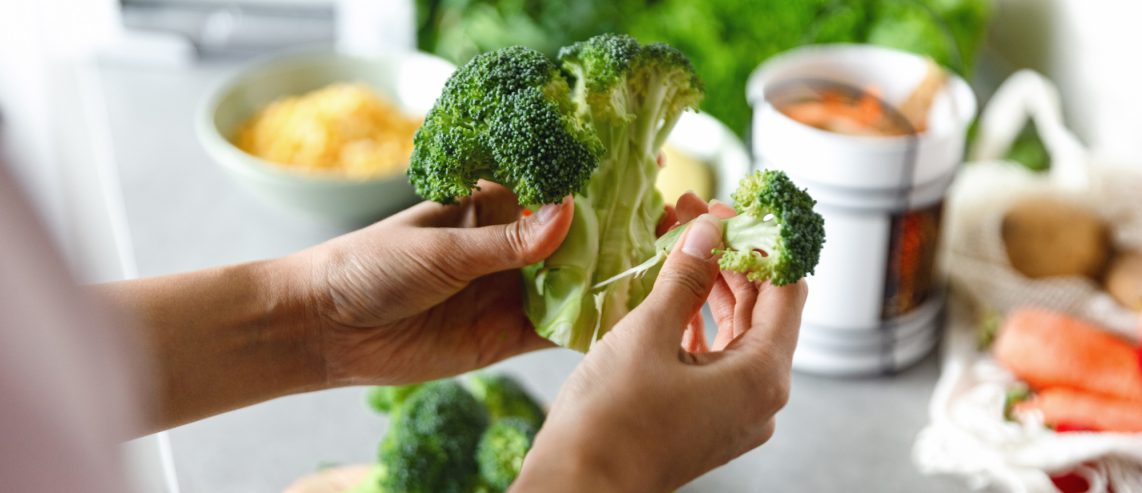How often does broccoli appear on your menu? If it’s infrequent, you might want to change that. This vegetable packs a punch of health benefits and is more versatile than you might think.
Learn why the health benefits of broccoli make it a top choice among nutritionists and ways to add more to your diet each week.
Broccoli Nutrition
There is no question that broccoli is a nutritional powerhouse. Many people even consider broccoli a superfood because of its many nutrients. It’s low in calories, high in fiber, and full of vitamins, minerals, and plant compounds that offer impressive health benefits.
According to the USDA, one cup of cooked broccoli provides these and other key nutrients:
- Calories: 55
- Protein: 4g
- Fat: <1g
- Carbohydrates: 11g
- Fiber: 5g
- Vitamin A: 1210 mcg (134% Daily Value, DV)
- Vitamin C: 101 mg (112% DV)
- Vitamin K: 110 mcg (92% DV)
- Folate: 168 mcg (42% DV)
- Potassium: 458 mg (10% DV)
- Calcium: 62 mg (5% DV)
Broccoli’s vitamins and minerals keep your body working well every day. Besides these, its antioxidants and other plant compounds protect cells from free radical damage and reduce inflammation that leads to chronic diseases.
Never Miss a Beat!
Subscribe to Our HealthBeat Newsletter!
Thank you for subscribing!
You can now select the specific newsletters you'd like to receive.
You are already subscribed.
Subscribe to more newsletters in our email preference center.
Sorry, an error occurred. Please try again later.
Get Healthy Tips Sent to Your Phone!
Broccoli Benefits for Cancer
Broccoli is a member of the cruciferous family of vegetables, which also includes superstars like cauliflower, kale, and cabbage. The word “crucifer” means cross, referring to the cross-shaped petals of the flowers on these vegetables.
Cruciferous vegetables are probably best known for helping reduce your cancer risk. The National Cancer Institute says some studies have found a lower risk of some types of cancer among cruciferous vegetable eaters. And broccoli has several anti-cancer compounds.
One of these is a sulfur-rich compound called sulforaphane. According to a 2023 review article in the journal Antibiotics, lab studies show that sulforaphane has anti-cancer properties. It can kill or prevent the growth of breast, prostate, lung, and colorectal cancer cells.
Interestingly, sulforaphane gives cooked broccoli its pungent smell and is the reason many people shy away from it.
Indole-3-carbinol, also called I3C, is another important cancer-fighting compound formed when you cook or chew broccoli. I3C stimulates detoxification in your gut and liver and promotes healthy estrogen metabolism. It may also help lower the risk of certain cancers, including breast and prostate cancer.
The antioxidants in broccoli also play a vital role in reducing cancer risk. Its antioxidants include:
- Beta-carotene
- Kaempferol
- Lutein
- Quercetin
- Selenium
- Vitamin C
These protect your cells from damage and keep them healthy, reducing the chance they might turn into cancer cells.
Other Health Benefits of Broccoli
Although broccoli’s role in cancer prevention often gets much attention, this stalky green vegetable has plenty of other health benefits, too. For example, the nutrients in broccoli can support:
- Bone health. Broccoli is a plant source of calcium, which helps keep your bones strong and healthy.
- Eye health. Broccoli’s beta-carotene, lutein, and other antioxidants can protect cells in your eyes and promote healthy vision. These compounds may reduce your risk of age-related macular degeneration (AMD) and cataracts.
- A healthy weight. It’s high in fiber and fills you up with very few calories. Eating more broccoli may help you feel less hungry between meals.
- Heart health. Broccoli’s fiber helps lower cholesterol while the antioxidants protect your heart and blood vessels. Eating more broccoli may reduce your risk of heart disease.
- Immune system function. Vitamin C and antioxidants support your immune system so it can fight off bacteria, viruses, and other foreign invaders.
- Normal blood clotting. It’s an excellent source of vitamin K, essential for normal blood clotting. NOTE: Ask your doctor about eating broccoli if you take blood thinner medicine, as it can interact.
- Skin health. Antioxidants in broccoli protect skin cells and may slow signs of aging. And its sulforaphane might protect you against skin cancer.
Raw vs. Cooked Broccoli
You can eat broccoli cooked or raw. Both have health benefits, so it’s worth eating the vegetable in various ways.
- Steaming until crisp-tender (on the stove or microwave) or quick-stir-frying are ideal cooking methods. These retain vitamins and activate sulforaphane and I3C. But chopping and chewing raw broccoli also activates these compounds.
- You’ll lose some, but not all of the vitamin C when you cook broccoli. But other compounds, like beta-carotene, become easier for your body to absorb when cooked.
- If you boil broccoli for a long time and discard the water, you’ll lose water-soluble vitamins, like vitamin C and folate. These leach into the water during cooking.
- If you prefer soft-cooked broccoli, add it to soups or stews toward the end of cooking. That way, any nutrients lost will remain in your broth or sauce.
Regardless of how you prepare broccoli, it tastes best when fresh and young, so look for smaller, bright green stalks and florets. Young stalks are tender, while larger, older stalks are tougher. If you have tough stalks, chop or shred them and use them as a crispy addition to a salad or slaw.
How to Eat More Broccoli
To reap the benefits of broccoli, start eating more of it! Buy a bunch or two each week and keep a bag of broccoli in your freezer; it’s just as healthy as fresh.
Try these easy ideas and tips to add more broccoli to your meals and snacks.
- Add chopped broccoli to an omelet or scrambled eggs for breakfast.
- Make broccoli pesto. Chop roasted broccoli in a food processor and puree it with olive oil, walnuts, fresh garlic, and Parmesan cheese. Use this as a sandwich spread, stir it into pasta, or spoon it over fish or chicken.
- Make a tasty coleslaw from shredded cabbage, carrots, and broccoli stems. Season with salt and pepper, and toss it with a creamy yogurt-based salad dressing.
- Lightly steam broccoli florets and cool them in ice water. Add them to a raw vegetable platter for snacking with hummus or a Greek yogurt dip.
- Saute broccoli with olive oil, garlic, and a pinch of red pepper for a fast and easy side dish.
- Add chopped broccoli to a mixed vegetable soup, or make cream of broccoli soup.
Eating more of this nutrient-dense vegetable is an easy way to improve your health. So don’t pass it up the next time you see it at the grocery store or farmers market. If you need help planning a healthy diet or making changes, talk to your dietitian.
Sources
Antibiotics. Broccoli: A Multi-Faceted Vegetable for Health: An In-Depth Review of Its Nutritional Attributes, Antimicrobial Abilities, and Anti-inflammatory Properties. LINK
Food Data Central. Broccoli, Cooked, Boiled, Drained, Without Salt. LINK
Percent Daily Value Calculator. LINK
National Cancer Institute. Cruciferous Vegetables and Cancer Prevention. LINK
American Institute for Cancer Research. Broccoli More Nutritious When Raw or Cooked? LINK
About UPMC Nutrition Services
Nutrition is vital for maintaining your overall health. UPMC Nutrition Services offers comprehensive diet and nutrition counseling on a variety of topics, including eating disorders, weight management, and heart disease. Our team provides medical nutrition therapy for chronic conditions such as celiac disease, cancer, and diabetes. UPMC’s network of registered dietitians is available to help guide all patients toward a healthier life.

